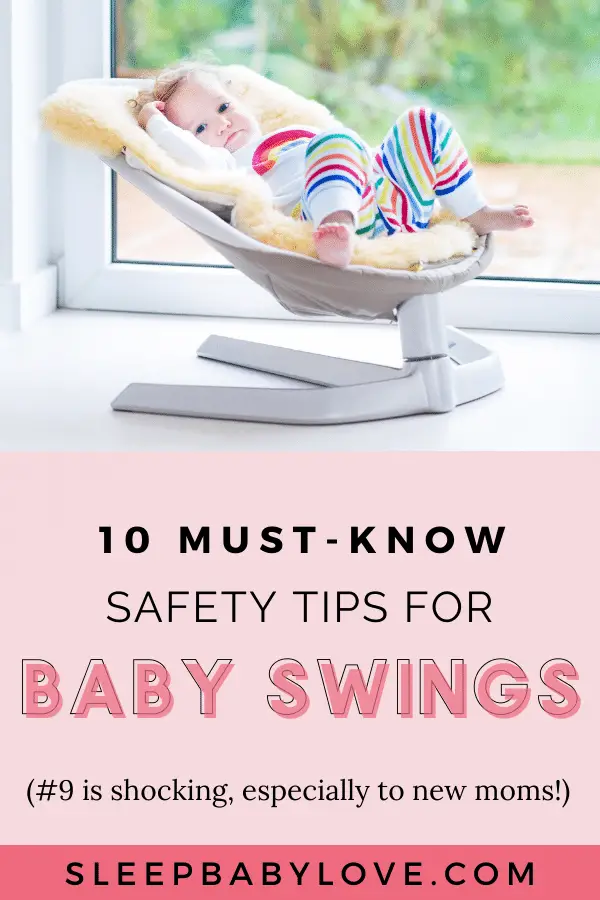10 Baby Swing Safety Tips
One of the most popular ways of keeping your baby settled, while you get other things done, is by placing them in a swing. A baby swing is supposed to keep the baby comfortable with gentle rhythmic movement. But still, you shouldn’t take your eyes off your baby. Studies have shown that at least one child dies annually from swing use. If this startling fact concerns you, be sure to follow these safety tips.
- Never Leave Your Baby Unattended— Although this is a hands-free method of caring for your baby, while you tend to other chores and obligations. However, just like in any other activity that you do with your child, you should never leave them alone. Even when the baby is on the swing, keep them in view at all times.
- Use The Safe Harness Provided—All baby swings should have a safety harness. A harness makes sure that the swing is secured, in case the baby decides to move a little. Whether or not you’re using the motion features on the swing, don’t forget to use the harness. Be sure to continually adjust this to your baby’s size, even if this means loosening it every week.
- Avoid Elevated Surfaces—It’s easy to leave the swing on top of a table, counter, etc. for convenient viewing. However, this becomes a problem if the swing tips over and falls off the high surface. So, the best place for the swing is on the floor, even if the swing is small. Having the swing on the floor reduces the risk of it toppling over if your baby moves around in it.
- Limit Swing Time For Your Baby—No more than a half-hour should be devoted to having your child be in the swing, especially on a rapid setting. Even when you’re tired, turn off the swing a little before thirty minutes is up. “Allowing your baby to be on the swing for hours will make them dizzy, making them sick. Even if your baby is content with being in the swing, you still have to limit their swing time,” explains Danielle Drew, a parenting blogger at State Of Writing and Dissertation Services.
- Mind The Toys—Swings may come with toys or mobiles that hang above the child as they lay there. Should the toys become detached, then you’ll risk seeing a choking hazard. Also, while light projectors on swings may seem fun at first, they can overstimulate children while using the swing. Be sure the toys are fastened securely, and have them out of reach from babies. But toys may also lead to your baby forming sleep associations, where your baby becomes distressed when they wake up without them there.
- Mind The Swing’s Weight Limit— “Every swing should have a weight limit posted on the packaging. These warnings should serve as a tool, so that parents and caregivers can practice safe and proper use of the swing,” says Virginia Adams, a health writer at Essayroo and Best Writing Services. Depending on how often your baby uses the swing, weigh them at least twice a month – they may reach this upper limit before you’d expect. However, a baby who’s too small to use the swing may slide straight out.
- Recline The Seat When Needed—According to the American Academy of Pediatrics, you have to choose a swing that best supports the baby’s head, when the seat is reclined. Being seated in a reclined position is especially recommended if your child is under the age of four months old so that it doesn’t restrict their airways. The child has to be able to breathe, while on the swing. This also prevents your baby from falling out, especially smaller babies.
- Start With Slow Motion Settings—Most swings let you adjust their speed or motion settings. You may want to start with the lowest setting, the slowest speed, when you place the baby on the swing. Babies don’t like when they’re being moved too fast or too harsh, or if you’re forcing the swing to move. Let the swing itself do the work, and again, make sure you start with the slowest motion setting. That being said, if your baby then seems to like being rocked quickly, feel free to use the fastest setting, just under careful supervision.
- Don’t Allow Baby To Sleep In Swing— Just because the baby falls asleep in the swing, doesn’t make it safe for them to do so. A swing doesn’t provide the same sleep benefits as a crib would. If your baby falls asleep in the swing, move them to the crib or a firm sleeping surface immediately. Just carefully get them out of the swing, and rub their backs to lull them back to sleep again. By doing this, you’re teaching the baby to be able to sleep on stable surfaces like the crib. If that gentle transfer doesn’t work, you will need to come up with a sleep training plan to make sure that the baby can fall asleep independently in the crib. Your baby will also get deeper quality, restful sleep when most of it is spent stationary like this, helping them grow faster.
- Know When To Stop Using The Swing—Over time, your baby will learn to roll over on themselves or to push themselves up using their hands and knees. Once they start learning these things, then those are signs that your baby won’t need the swing anymore. Using the swing in this phase in life will risk having the baby climb out and hurt themselves. The absolute limit is nine months, but they could reach the swing’s weight limit before then.
Conclusion
Ultimately, it is up to parents like you to learn about baby safety and to make the right choices when you use baby swings.
Beatrix Potter works for both Top assignment writing services in New South Wales and Best Custom Paper Writing Services. As a professional writer, she writes about parenting, which is her popular topic. She also provides tutoring services at UKWritings Review. In her spare time, she likes to travel, run, and read various genres.

